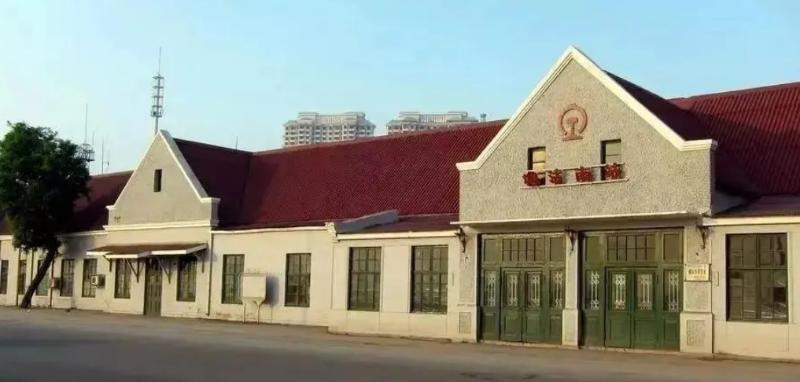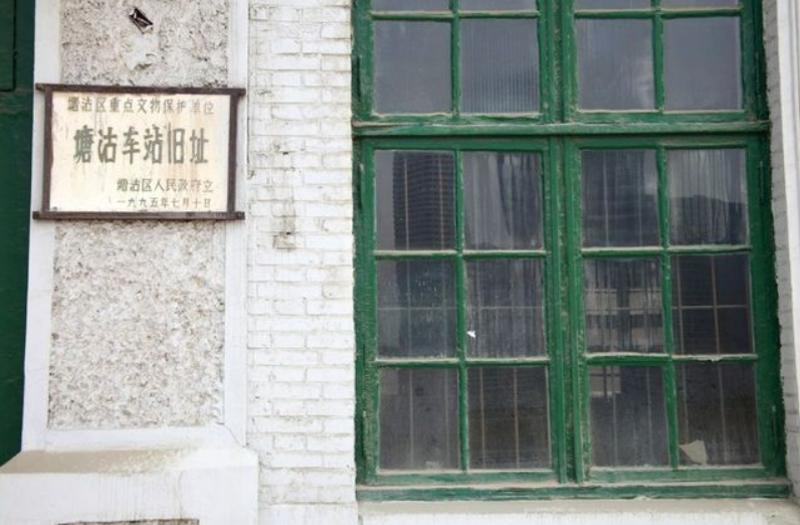Honors of Tanggu South Station: A Testament to History
With a history of 130 years, Tanggu South Station stands as one of China's earliest and most intact preserved railway stations. It marks the endpoint of the original Tangxu Railway Extension Line, constructed in 1888 and later renovated in 1907. Near the main station building stands a two-story structure, with the inscription "TANGKU" still visible on its walls. In 2007, Tanggu South Station was listed as one of the "Ten Immovable Cultural Relics in Tianjin," alongside other significant sites such as the Beiyang Navy Dagukou Shipyard Ruins, the "Gang 5 Well" of the Dagang Oilfield, the Former Fujuxing Machinery Factory Site, and the Jincheng and Yangliuqing Stations of the Tianjin-Pukou Railway, among others.

Reference: Exploring the Cultural Charm of Tanggu Railway Station Site: A Retrospect of a Century of History
In the late Qing Dynasty, coal mining began in Tangshan, prompting Li Hongzhang to plan the construction of a railway from Tangshan to the northern seaport of Beitang. After numerous obstacles, the Tangxu Railway was completed in the seventh year of the Guangxu Emperor's reign (1881), extending from Tangshan to Xugezhuang. The following year, it was extended from Xugezhuang to Lutai, named the "Tanglu Railway." In the fourteenth year of Guangxu's reign (1888), the railway was further extended to Tanggu and then to Tianjin, becoming known as the "Tangjin Railway."
Originally named "Tang'ergu" in Chinese, the name was simplified to "Tanggu" by the British chief engineer, John Genda, who found it difficult to pronounce in English. Since then, the name "Tanggu" has appeared on maps. Therefore, it can be said that the name "Tanggu" was coined by the British.

Initially, Tanggu South Station had a "person"-shaped track layout, which was not conducive to train operation. Soon after, the "person"-shaped track was removed, and a U-shaped 90-degree curve was laid near Tanggu's Xin Gang Road and Chaoyang Street. Trains entering the station could now navigate the curve without needing to turn around on a turntable. This curve, known as the "Old Curve," is still in use today.
In its early days, Tanggu South Station lacked platforms and consisted only of a few bungalows. In 1907, with the opening of the Beijing-Fengtian (Shenyang) Railway, Tanggu South Station built a waiting room with a brown exterior, pointed roofs, and stylish circular lamps above the doors. Up and down platforms were constructed, along with a footbridge, and a shelter was erected on the down platform for passenger rest.
Subsequently, Tanggu South Station was equipped with freight lines, with 15 dedicated lines reaching the Haihe River docks. When the Haihe River became silted and ships could not reach Tianjin Port, passengers and cargo disembarked here and transferred to trains. By the 1930s, Tanggu South Station mainly transported kerosene, salt, and raw materials for nearby factories during the Anti-Japanese War.
However, there were also passengers traveling, mostly residents commuting from Tanggu and employees of the Mobil and Dahua oil companies. The area in front of the station was always bustling, with passengers boarding and disembarking, shops selling goods, and carts transporting cargo, creating a lively scene. Train stops at Tanggu South Station were brief, and as soon as the train stopped, station staff began organizing departures. However, vendors still seized the opportunity to sell crabs and shrimp to passengers on the platform, their voices mingling with the announcements of station staff.
Tanggu South Station has also witnessed many historical moments. In the winter of 1919, a group of young people arrived at Tanggu South Station, including Mao Zedong. Luo Zhanglong, who was among them, recalled decades later: "Friends who were sent to France for work-study passed through Tianjin. They deliberately came to Tanggu to see the sea. After eating cabbage and pork buns at a small restaurant near the South Station, they walked to the Dagu Battery. When they returned, they were carrying a large bag of shells, which were checked by the station police at the South Station."
In 1933, as the Japanese army advanced towards the Great Wall, the Nationalist government sent Xiong Bin and Kankichi Ogura, chief of staff of the Kwantung Army, to sign the "Tanggu Agreement" at Tanggu South Station's western "Japanese Mansion." In 1937, the Japanese transported plundered goods and tens of thousands of Chinese laborers from China to Tanggu South Station, where they were then shipped to Japan. After Japan's surrender, Chinese laborers returning from Japan gradually disembarked at Tanggu Port and transferred to trains to return home.
In the early 1960s, the transport of bulk grain became an important task for Tanggu South Station. Utilizing dedicated lines directly connected to the Haihe River, it transported passengers and cargo landed at Tianjin Port to various parts of the country. Salt, alkali, fish, and shrimp produced in Tanggu were transported nationwide, while coal, ore, fertilizers, and cement from other regions were shipped to central and southern China. The volume of goods transported by Tanggu South Station increased year by year, and the variety of goods transported expanded.
Passenger transport at Tanggu South Station mainly consisted of suburban trains between Tianjin and Tanggu, commonly known as "Tanggu Shorties." For old Tanggu residents, "Tanggu Shorties" left a deep impression. The starting station was the Xin Gang 300-ton Station, and the train moved slowly through Tanggu at a speed of no more than 10 kilometers per hour, gradually picking up speed after leaving Tanggu. Stops included Tanggu, Junliangcheng, and Zhangguizhuang, with Tianjin Station as the terminus, with a ticket price of 1.2 yuan. The journey was similar to the current Line 9 of the subway.
In the 1980s, when "Tanggu Shorties" were at their peak, there were up to four trains running daily between Tanggu South Station and Tianjin Station, with additional services to Xin Gang 300-ton Station on Sundays. For a considerable period, "Tanggu Shorties" effectively shortened the distance between downtown Tianjin and Tanggu. At that time, there was only one bus line between downtown Tianjin and Tanggu, with "Tanggu Shorties" being the main mode of transportation. To maximize passenger capacity, the carriages only had two long benches on each side, with the middle filled with standing passengers. Each carriage could accommodate 200 people, and a train consisted of fourteen carriages, capable of carrying 3000 passengers. It was impossible to board on weekends due to overcrowding.
On October 7, 2004, at 7 a.m., the last train from Tanggu South Station to Tianjin Station, Train No. 4492, departed as part of the fifth nationwide railway speed increase. The bustling Tanggu South Station passenger platform fell silent thereafter. Some collectors preserved old-fashioned cardboard tickets from Tanggu South Station, which were
still in use despite being phased out elsewhere, as mementos of history.
note: This return of all, without the author's permission, may not be reproduced